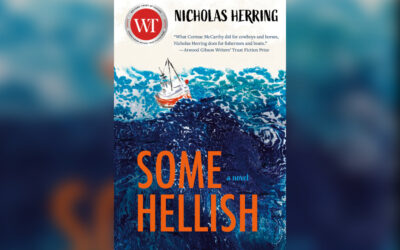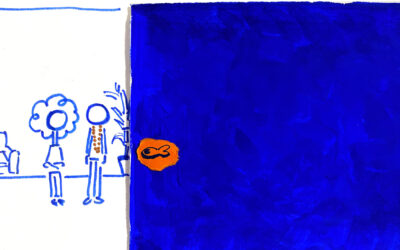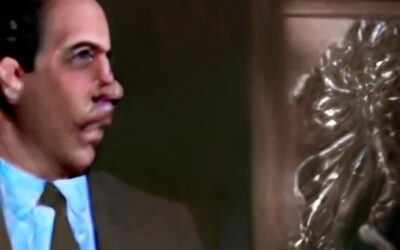Blog
Review: Some Hellish by Nicholas Herring
A quick scan of tourism sites for Prince Edward Island brings up photographs of red sand and lighthouses, as well as the occasional image of a redheaded young girl with two braids. Nicholas Herring’s novel Some Hellish is firmly planted on that same island but could not be farther from the bright whimsy of travel advertisements or children’s book covers. It follows a middle-aged fisherman, who shares the name Herring, quietly experiencing an existential crisis of sorts while going through the motions of his daily and seasonal work.
The Mediterranean in a Condo
“Why is there only one fish?” I asked him.
In his new place, I saw he had a huge aquarium. Where there should be a window from floor to ceiling, he had an aquarium, with one goldfish inside. What’s the word for an aquarium that has only one fish? Is it an aquarium or is it an artwork? I wondered if he was doing something similar to Marco Evaristti’s Helena with the fish and the huge tank: some sort of sadistic gesture.
Khashayar Mohammadi’s WJD: an English-Language Introduction to Islamicate Nuance
Since the dawn of ‘Western’ civilization, it’s been customary for aging pop-intellectuals (or whatever the equivalent role was at a given time) to point to a dichotomy between the East and West. Today, and excuse my polemics, mediocre faux-intellectuals point to a regressive, ecclesiastical East dominated by Imams and oligarchs, and contrast it with a progressive, technocratic, civilized West. WJD, a collection of poetry from Khashyar Mohammadi, is an ethnography of the margins of the Islamicate world, and, in my eyes, a scathing critique of Euro-American reductionism and today’s incarnation of orientalism.
The Art of Nothingness: An Approach to Appreciating Chinese Art
The elaborate polyphony and ornamentation of Baroque music. The innumerable strokes and saturated colours of an oil painting. The meticulous turn of argument in a sonnet’s volta. This is perhaps what makes up the European “sublime” that, mesmerically and almost overwhelmingly, leaves us frozen in awe.
So perhaps you may wonder, what is there to listen to in a piece of music with only a single melody line? To see in a painting that is only a few strokes in monotonous ink? To read in a poem composed of short, standalone lines of simple imagery?
And yet, these artworks are praised to might as well be the epitome of Chinese art.
Reading Bogotá, Colombia as an Apocalipsis by Mario Mendoza
The tricky aspect about loving your hometown is that it’s difficult to explain why. You are more than willing to defend your homeplace when someone else takes a hit against it, but you are also its harshest critic—or, at least, that is the case for me.
Introducing Terminally Online Lovecraftian Comedy
I experience the existential horror of sci-fi literature in a strange, almost counterintuitive way. While it seems that I’m immune to Lovecraft’s insidious neuroticism, I experience unbound dread and awareness of my own minuteness when I read the sprawling space operas of Isaac Asimov. I always read the former casually tearing through an increasingly decrepit anthology of stories my mother bought me for my birthday one year, but I shudder at the thought of ever touching anything written by H.G. Wells. For me, Lovecraft’s At the Mountains of Madness is a romantic romp through Antarctica’s ancient past, but narratives of intergalactic empires and cyborgs grim reminders that time is running out and everything returns to dust. In my relatively uncreative mind, I used to implicitly assume that these two sides of fiction were never bound to intersect; that changed when I was sifting through shitposts one day and came across, alas, a serious post from Instagram user @theclockspider!
A Few Words About Blowjobs
I could tell he was over it. I could tell that my once-endearing traits had become a nuisance — could practically hear the internal pep talks he’d give himself in anticipation of playing the field again. When Max Freeman finally dumped me three months later, I asked, “why’d you spend the summer with me only to bail come September?” Although Max did not reply, I suspect an honest answer would include “blowjobs.”There’d been a time when Max Freeman thought the world of me. A time when everything I said was so clever and amusing, a time when the sound of my voice was something like silk, but my time would soon be up. He’d begun to drift, and I intended to suck him back into my orbit.
More Pride than Prejudice: Queering Jane Austen in Joel Kim Booster’s Fire Island
As with many Austen retellings, the first line of narration in Joel Kim Booster’s romantic comedy Fire Island (2022) echoes the instantly recognizable first line of the novel to which it owes its plot. “It is a truth universally acknowledged that a single man in possession of a good fortune must be in want of a wife,” quotes the narrator and protagonist, the feisty and outspoken Noah, played by Booster himself. “Well, no offence to my girl Jane Austen,” he adds, “But that sounds like some hetero nonsense.” Obviously, Pride and Prejudice’s heroine Elizabeth Bennet, to whom Noah serves as a parallel, would have no idea what that means.
Taylor Swift’s Midnights: Edgiest Album Yet?
Taylor Swift's Midnights: Edgiest Album Yet?Folklore, coupled with the nostalgia which Taylor Swift’s album re-releases inspired in me, were enough to transform me—a previously indifferent fan—into a full-fledged Swiftie. In the past two years, I’ve devoured Swift’s...









